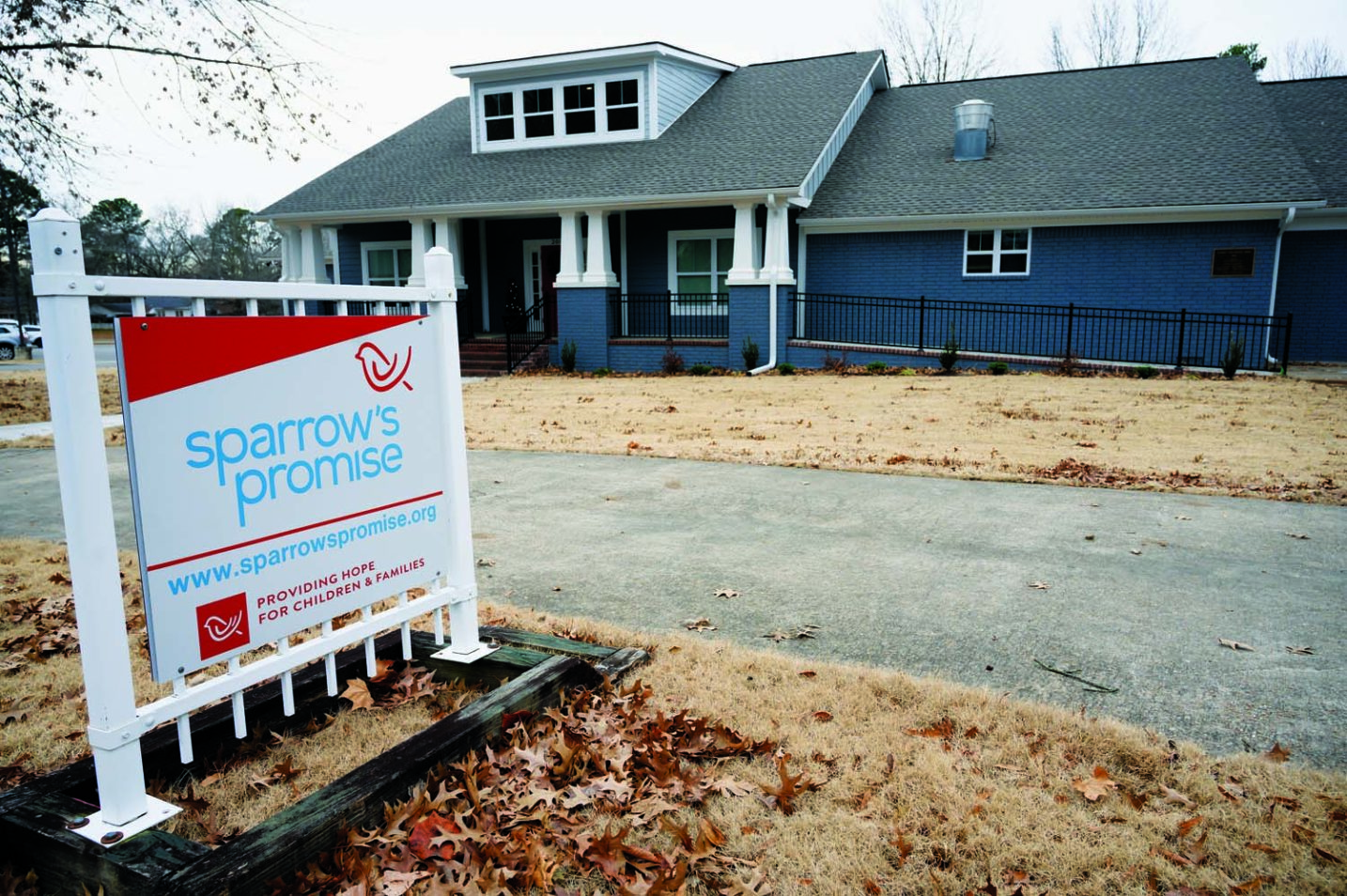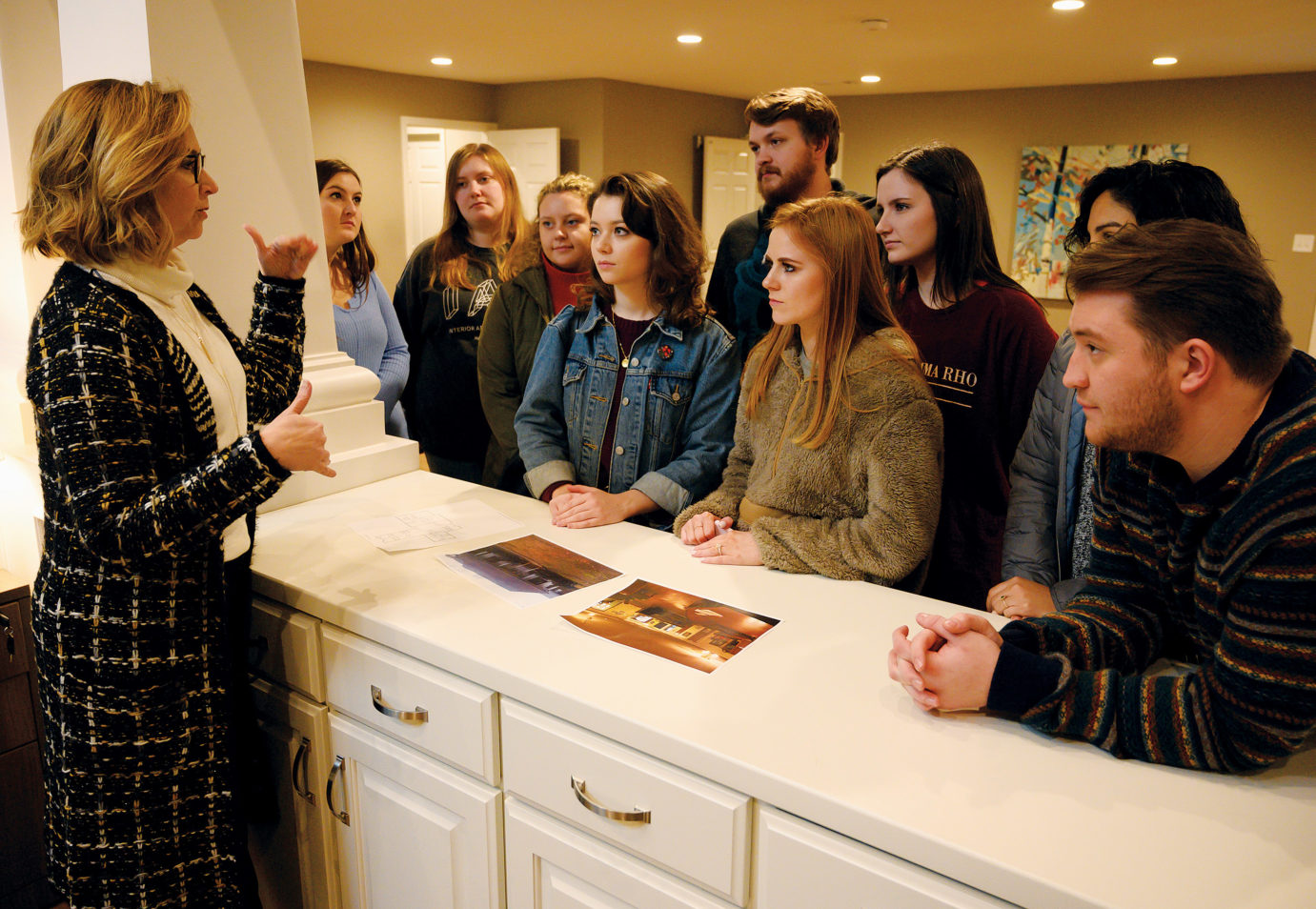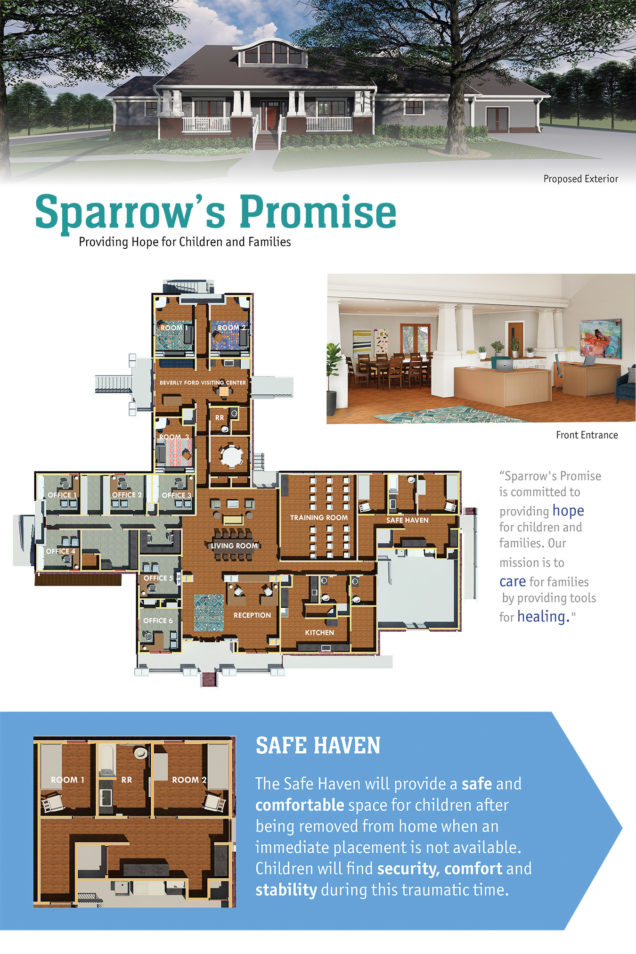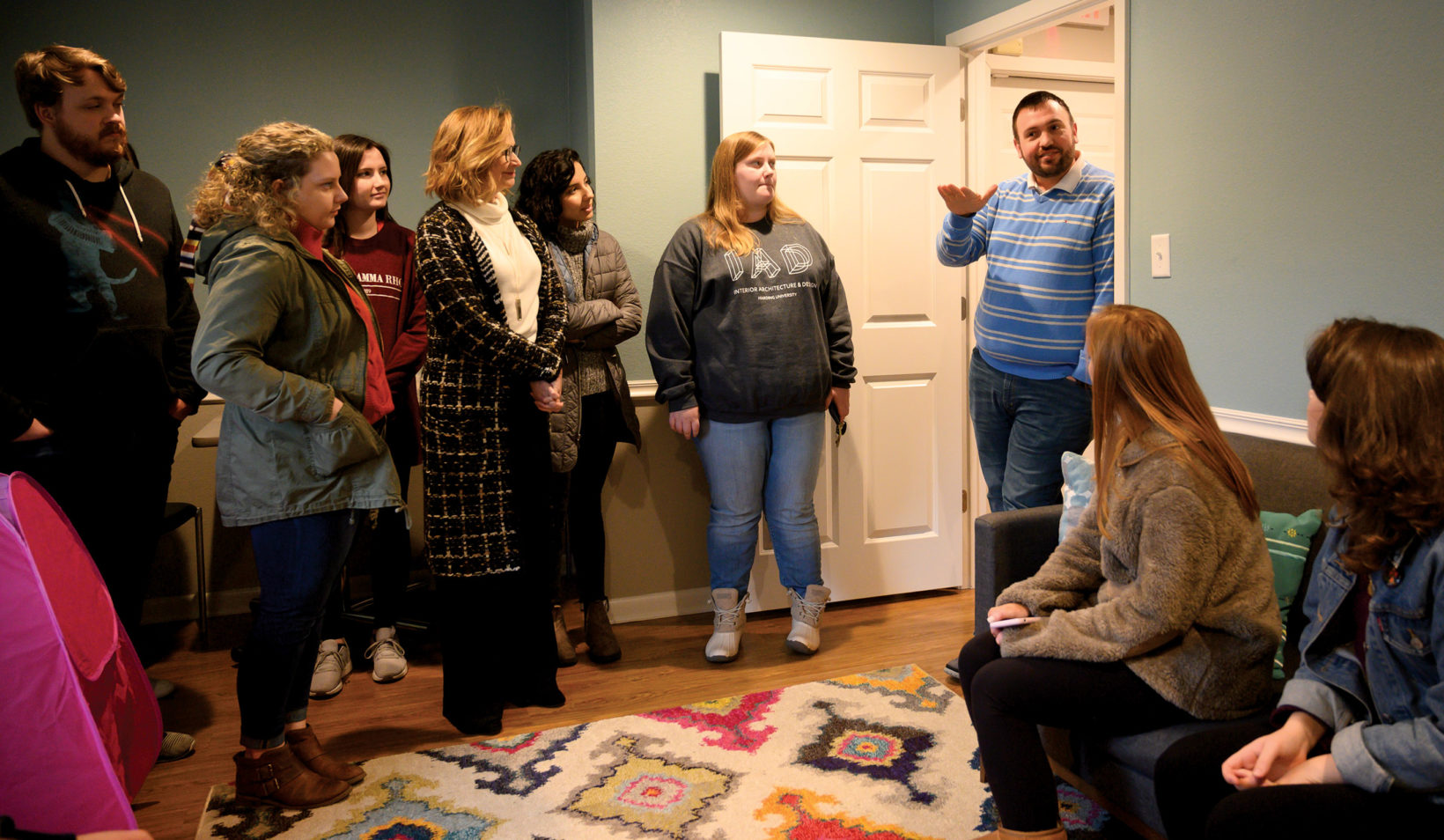By Megan Stroud | Photography by Jeff Montgomery

The red door on the house on Moore Avenue in Searcy opens to a spacious, naturally-lit room with tall ceilings. Looking past the desks at the front, a large dining table and living room welcomes parents and children, no matter what their backgrounds may be. The house was previously Searcy Children’s Home, but, with the help of interior architecture and design students from the University, it is now a renovated space with a new purpose.
The trend of moving away from group homes and toward foster care left the former Searcy Children’s Home searching for a new way to stay involved with families in the community. After several years of planning, brainstorming and offering transitional services including a day care, the board of directors, led by chairman Andrew Baker (’98), approved a new concept — Sparrow’s Promise.
“We were trying to come up with something that captured our mission, but we needed to get away from the children’s home image because we don’t have kids that live here anymore,” executive director Brandon Tittle (’04) says. “The idea for the name came from Matthew 10 where Jesus talks about the sparrows. He says they won’t fall to the ground outside of the Father’s care. That promise spoke to us because that is exactly what we are trying to do. We are trying to come alongside people who are going through a hard time and say, ‘We care about you, we are going to help you, we are going to fight for you, we are going to support you, and we want to specifically help you get your kids back and get your family back together.’ Through that we are able to share the promise that we love you, but even bigger than that, God loves you.”

Just changing the name, they realized, was not adequate. The original footprint of the structure did not support the new vision. Baker discussed the project with assistant professor of art Amy Cox (‘98), and a specific request from the Department of Human Services revealed the need for a family visit center. With the help of Cox, interior architecture and design students at Harding, Mike Steelman at SCM Architects, and Patrick Connell at Connell Construction, the building is now suited to meet three diverse needs with three wings: the family visit center, a safe haven and an administrative wing.
THE BEVERLY FORD FAMILY VISIT CENTER
While the new purpose for the building was still being determined, DHS specifically requested a space where foster children and biological families could have more successful supervised visits.
“The visits are the number one indicator of reunification, so we need the visits to be productive and conducive to building a bond between the parents and the children,” Tittle says. “The more they can build that bond, the harder they are all going to work for reunification.”
Creating a space that encouraged positive family time during these visits became the primary focus of Cox and her students.
“Having had [foster] kids before, I knew the real challenges with that — taking them to McDonald’s and then picking them back up, and they didn’t really visit,” Cox says. “I believe that the physical environment around you has a very direct effect on things, including relationships as well as attitude, memory and connectivity. We take it for granted. It doesn’t just look pretty, but our spaces really do physically and emotionally affect us. So to have a visit at DHS where you feel frustration and hurt and anger and trauma, they associate those bad feelings with [the visits at DHS].”
Senior thesis projects for interior design majors at Harding are focused on finding social issues that design can aid in solving. Three groups of seniors over the course of three years helped Cox with phases of the Sparrow’s Promise remodel.
The first group of seniors focused on design research. They looked at the impact of the visits on everyone involved — children, biological parents and foster families — through research in the fields of psychology and social work.
“I think most people don’t fully understand the amount of thought that has to go in even before you start laying out a space or picking out colors; you have to get the beginning of it right,” Cox says. “You have to fully be able to empathize before you can design a space that has meaning and has a physical or emotional effect.”
The research showed need for autonomy and connection. The small kitchenette, indoor rooms and backyard let families pick from a variety of activities. The activities and furniture in the rooms were selected specifically to encourage physical touch, comfort and memory making. The loveseat and rocker allow families to sit together, and the motion reduces stress for both parents and children. The bench seating allows for flexibility with larger family visits, and the games and toys were specifically selected to encourage children to connect with their families rather than playing alone. The mismatched accessories create a comfortable atmosphere; it’s not a pristine space they will mess up.
“[Parents] have lost control when they lose their kids, and the courts are looking at them very harshly,” Cox says. “They’ve pretty much lost control of everything. If they can kind of choose how they want to spend that visit, we thought that was important.”
The role of the caseworker in the room was also given specific attention. Their presence, while necessary, needed to be noninvasive. Cox teaches her students each semester about the eight-foot triangle — you are unlikely to interact with anyone further than eight feet from you in a room. The long, narrow rooms allow the social worker to sit outside this eight-foot range.

The soft, cool color scheme of blues and greens alongside large windows for natural light were chosen to reduce stress, create calm and build a backdrop for memorable children’s artwork.
“All those were decisions to create memory moments that, even if they don’t go home to their parents, the last places that they visited their parents will be positive places,” Cox says.
The second group of seniors who participated in the project worked with architect Mike Steelman to create an as-built floor plan of the existing building, a space plan and a layout. They measured walls, windows, doors and rooms and redesigned the layout to help the building change functions. After the students designed the interior, Steelman and Cameron Sunkel (’18), his intern at the time, worked on the structure and exterior architecture of the building.
“It was a team effort on the part of everybody, but I will say that interior design, including students, carried the majority of the load,” Steelman says. “Interior design is an amazing program at Harding. They do a great job in terms of educating students.”
Toria Adkison (’19), a member of the final senior class to work on the project, worked with Cox on a different level. She played a key role in painting the mural, communicating with suppliers and helping Cox pick the specific materials for the space.
“It was great to work on this project during school because I saw what professional design looks like firsthand,” Adkison says. “I met with the clients, negotiated with furniture dealers, and saw our ideas come to life during the course of my last year at Harding. Working alongside Amy Cox allowed me to apply practical design principles taught in our program. Sparrow’s Promise provided connections to a wonderful community in Searcy while boosting my confidence in design. It gave me hope that there is purpose in design, and I strive to carry that on as I work in the professional world.”
Even in the early stages of hosting visits in the completed center, differences in the visits at Sparrow’s Promise are already evident.
“Here you see parents down on the floor playing with their kids, which isn’t going to happen at an office or a restaurant,” Tittle says. “Seeing that interaction where the parents get down on the same level with the kids — playing with them, sitting in the rocking chair feeding them bottles, it definitely seems more natural, calm and appreciated.”
Changes are not only being noticed by the staff at Sparrow’s Promise. The DHS workers are also noticing a difference through their interactions with the biological families.
“It has become, as DHS put it to me, the gold standard of the state,” Baker says. “I’m not sure we meant to be the gold standard. We just wanted to try to create something better than what was.”
THE SAFE HAVEN & ADMINISTRATIVE WING
In the midst of the trauma of removing a child from their home, caseworkers have no designated place, other than their office, to go until a foster home is found and ready.
The Safe Haven, naturally created from the wing that was a day care, provides a place for social workers in White and Woodruff counties to bring children at any time of day. Donated supplies, a full bathroom and bedrooms are available to ease the transition and provide some comfort until a foster home is ready.

“That act of removal is traumatic, and everything that happens after that is stressful,” Tittle says. “They need a place to stay and wait. They used to be able, especially in the middle of the night, to take them to a hotel, but they can’t do that anymore, so they are just going back to their office. So we created this space. The initial trauma we cannot take away, but we can reduce the stress of everything that happens after that by giving them a place that feels like a home.”
When the interior design students began laying out the administrative wing, they knew the final need for the building would be common spaces, a training room and a professional environment for the individuals who work at Sparrow’s Promise. In addition to helping families have more healthy spaces to connect, research shows that design also affects the workplace culture and worker retention.
“I know in the industry of social work, there’s a lot of turnover and burnout,” Cox says. “So that was a secondary thing I had in mind. These people, these case workers especially, are so emotionally involved day after day after day, all hours of the night. And so that was another one of my goals, even though they didn’t really ask for it. When they walk into work every day for them just to want to be there and feel supported.”
Off the main living space there is also a multipurpose training room that can be used to train foster families or for DHS to meet with biological families.
THE COMPLETED REMODEL
With the completion of the project, Sparrow’s Promise is now a house with three wings that function independently.
“We were able to do that building far, far less expensively than it looks, and I think it’s important for people to know that we really were good stewards of their money,” Cox says.
Interior and architecture design students who were able to put their fingerprint on this development now have a real project in their portfolio and have experience working with professionals like Connell who says he saw no difference in working with them and working with other professionals already in the field.
“Most projects in school they design — it’s all hypothetical,” Cox says. “It never gets built. Even though three groups of seniors worked on it, they all get to now see it and have contributed along the way. That gets everybody in the program excited to do more community work like that. I couldn’t have done it if I didn’t have students.”
The project, which flowed right into Cox’s regular teaching, provided her a sense of pride both in the project and also in her students.
“Other projects that I’ve worked on I’ve been proud of, but I felt, when it was all said and done, that this place has a chance to really affect the lives of people,” Cox says. “Not every project has that much of an opportunity — that dramatic of an effect that it could. It was more than a building. It really gets at the heart of what they’re trying to do as a community.”
Cox, Baker, Tittle, Steelman and Connell all have been touched by Searcy Children’s Home through adoption or foster care, and now all their lives have been touched by helping Sparrow’s Promise continue the work began by Searcy Children’s Home — bettering the lives of the children in the community.
“Seeing and knowing what these kids go through on a day to day basis and just trying to do anything that we could to help alleviate a little bit of that pulls at the strings of the heart,” Connell says. “If you can do something that will give them a little bit of happiness for five minutes in their lives, we will jump through hoops to make that happen. We all wish there was a world where there was not a need for the foster care system, but that is not the case, and it’s not going to be the case. So we need places like Sparrow’s Promise that have a heart and want to do things for these foster kids to improve their lives and focus on those kids.”